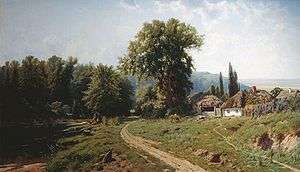Khutor
A khutor (Russian: ху́тор, IPA: [ˈxutər]) or khutir (Ukrainian: ху́тiр, khutir, pl. ху́тори, khutory) is a type of rural locality in some countries of Eastern Europe; in the past the term mostly referred to a single-homestead settlement.[1][2] The term can be translated as "hamlet".[3][4]

They existed in Cossack-settled lands that encompassed today's Ukraine, Kuban, and the lower Don river basin while in Kuban and Don region the word khutor was also used to describe new settlements (irrespective of the number of homesteads) which had detached themselves from stanitsas.[5] In some Cossack communities, these types of settlements were referred to as posyólok or sélyshche. In Russia the term "выселки" (vyselki, literally, "those who moved away") was also used. Khutor remains the official designation of many Russian villages in these regions.
During the Stolypin reforms in the Russian empire, Peter Stolypin envisaged rich peasants "privatising" their share of the community (obshchina or tovarystvo) lands, leaving the obshchinas, and settling in khutors on their now individually owned land. A less radical concept was that of an otrub (отруб) or vidrub: a section of formerly obshchina land, whose owner has left the obshchina but still continued to live in the village and to "commute" to his land.[6] By 1910 the share of khutors and otrubs among all rural households in the European part of Russia was estimated at 10.5%. These were practically eliminated during the collectivisation in the USSR.[1]
In literature
Nikolai Gogol's first major work is called Evenings on a Farm Near Dikanka, where 'farm' is a translation of 'khutor' (Russian: Вечера на хуторе близ Диканьки, Vechera na khutore bliz Dikan'ki).
See also
References
- Khutor from the Great Soviet Encyclopedia (in Russian)
- Khutor from the Brockhaus and Efron Encyclopedic Dictionary (in Russian)
- Українсько-англійський переклад «хутір» - ABBYY Lingvo-Online
- Російсько-англійський переклад «хутор» - ABBYY Lingvo-Online
- Khutir at the Encyclopedia of Ukraine
- Otrub from the Great Soviet Encyclopedia (in Russian)